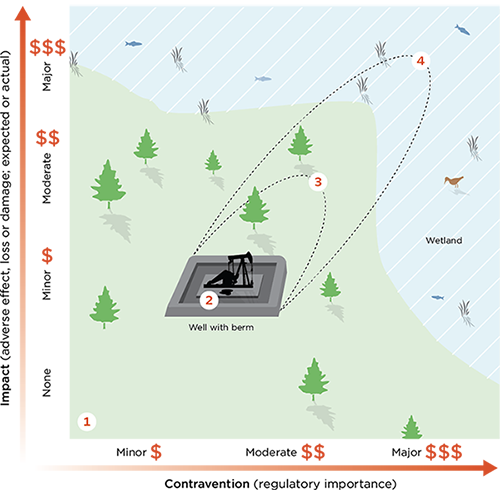Companies that fail to follow our requirements will face enforcement action, which might include an administrative penalty. The amount of the administrative penalty will differ based on the seriousness of the contravention and the impact it has on public safety, the environment, or resource production.
Other factors that will impact the amount of the administrative penalty include
- the importance of compliance with the provision to the regulatory scheme;
- the company’s willfulness in committing the contravention;
- the company’s history of compliance with our requirements;
- the economic benefit, if any, the company derived (or could derive) from the contravention; and
- any other factor that we consider relevant.
If the contravention occurs over a number of days, we can issue a penalty for each day. The maximum daily penalty is $5000.
Under the legislation we administer, we are also allowed to assess and collect a separate, one-time amount if it is determined that the company has derived an economic benefit directly or indirectly as a result of the contravention.
How Penalties Are Determined
We use a scale to assess companies’ contraventions, and ultimately, to determine our issued penalty amount. In short, the more serious the contravention and the greater the impact, the higher the penalty will be.

Our Contravention Scale
Major: release of a substance to the environment with the potential to cause an impact; failure to report a release; threat to public safety; activity is unauthorized and wouldn’t have been approved; failure to conserve an energy resource; or intentional disregard of requirements.
Moderate: failure to meet performance requirements, immediately report a contravention of the conditions of an approval, submit a required report, or perform required tasks in authorization or legislation; or activity is unauthorized but might have been approved.
Minor to none: administrative issues are related to documentation (e.g., late submission of required report).
How We Assess Impact or Loss/Damage
Major: release of a substance to the environment or a risk to public safety occurred or was likely to occur; release of a substance to the environment that would have caused lasting damage over a significant period of time if immediate action wasn’t taken; or the loss of an energy resource.
Moderate: moderate risk to the environment or public safety if the contravention wasn’t addressed.
Minor: loss or damage unlikely to occur.
None: no potential for damage or resource loss.
Examples
Many different situations could result in a penalty. However, to help put things into context, we share a few examples of what actions could result in a penalty if an oil spill took place. Please note that these are only examples. We look at each situation individually to decide how to classify a contravention.

| 1. Contravention: Minor
Impact: None |
2. Contravention: Moderate |
3. Contravention: Moderate |
4. Contravention: Major |
*Please note: this information does not apply to administrative penalties assessed under the Mines and Minerals Act.
Learn about other compliance and enforcement tools that we use to ensure that companies comply with our rules, regulations, and requirements.


